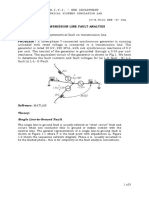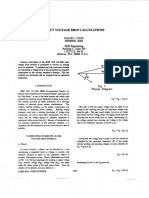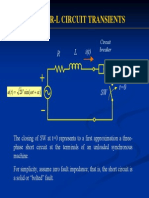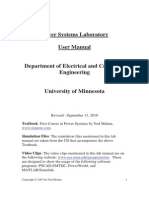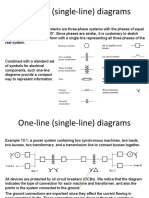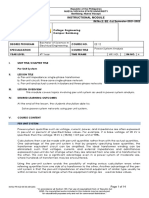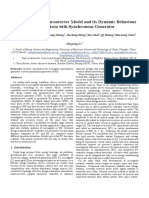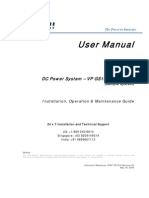EXAMPLE 18.
6
In the system shown below, the generator is ideal (XS = 0) and the magnitude of the
load bus voltage, VL is to be held at 110 kV. Working on a system base of 100 MVA
and a base voltage of 115 kV in the load circuit:
a) draw the single-phase equivalent pu reactance diagram, and
b) determine the necessary generator terminal voltage VG (kV).
Solution
a) We must note that the presence of the transformers causes the base voltage to
vary as we move back from the load toward the generator. We are given:
VBload = 115 kV, as the base voltage in the load circuit, while:
500
VBline = 115 x = 500 kV , is the base voltage in the line circuit. Likewise:
115
25
VBgen = 500 x = 20.83 kV , is the base voltage in the generator circuit.
600
Since transformers do not alter power, the base power remains at 100 MVA
throughout the system.
We apply the per-unit notation by dividing actual quantities by the base quantity.
110
At the load: VL = ∠00 = 0.9565∠00 pu
115
120
SL = ∠ cos −1 0.85 = 1.2∠31.80 pu
100
∗
⎛ S ⎞ 1.2∠ − 31.80
I = ⎜⎜ L ⎟⎟ = = 1.255∠ − 31.80 pu
⎝ VL ⎠ 0.9565∠0 0
The per-unit value of the current is the same in all parts of the circuit since the
transformers do not alter current in per-unit form.
� The reactance of transformer 2 is given on a base of 115 kV, which is what we
want, but the power rating is 150 MVA while 100 MVA is required. So the following
change is needed:
X T2 = 0.06 x
(115 )2 100 = 0.04 pu
(115 )2 150
It is concluded that 6% on a 150 MVA base is the same as 4% on a 100 MVA
base, if the voltage base is unaltered.
The reactance of transformer 1 is given on a base of 25 kV, however, we need to
use a base of 20.83 kV and the power rating is 200 MVA while 100 MVA is required. So
the following change is needed:
X T1 = 0.05 x
(25 )2 100 = 0.036 pu
(20.83 )2 200
The reactance of the line is given in ohms, so we need to determine the base
reactance, i.e.
(V )2 (500 )2 = 2500 Ω
X B = BL =
SB 100
∴ X line = 60 = 0.024 pu
2500
The single-phase equivalent in pu form is:
b) VG = VL +jXTOTAL x I
VG = 0.9565/0 + j0.1 x 1.255/-31.8 = 1.028/60 pu
The 60 angle can be neglected when converting the magnitude back from per-unit, i.e.
VG = 1.028 x 20.83 = 21.4 2 kV .
The per-unit system is also useful for calculating fault levels on a power system.
This is very important when deciding how large a circuit breaker has to be and the trip
level of its associated relay. For balanced faults (all three phases shorted) this is
modeled by connecting the phase conductor to the system neutral in the single-phase
equivalent.
�EXAMPLE 18.7
Refer to example 18.6 and determine the fault level (kA) at the bus whose voltage is
labeled VT2. Note that the fault level is the current that will flow into a fault at the
position stated. Assume that the load does not contain any components that will feed
current into the faults, so that all fault current flows from the generator.
Solution
If this was the largest fault current that would flow through the associated circuit
breakers then it would be used to determine the rating (size) of the breakers. If, on the
other hand, it was the smallest fault current then it would be used to set the relay that
would send the signal to trip the breaker and interrupt the fault.
� It is important to note that motors are the largest component of power system
loads and that they will feed current into faults for a few cycles i.e. they become
generators and cause fault levels to be higher. They briefly become generators
because voltage levels collapse during faults and the stored mechanical (kinetic) energy
flows out of the motor in the form of electricity. Precise fault calculations with motors
are very complex, but a simple rule of thumb states that 400% of the full-load running
current (FLA) of the motor will flow in to the fault. This models the motor as a constant
current source feeding into the fault and is sufficiently accurate for our purposes.
When fault levels are known at a supply bus the bulk power system can be
replaced by its Thevenin equivalent, to allow downstream fault levels to be calculated,
as shown in the following example.
EXAMPLE 18.8
For the system shown below, determine the balanced, bolted three-phase fault level at
the 4.16 kV bus.
Solution







